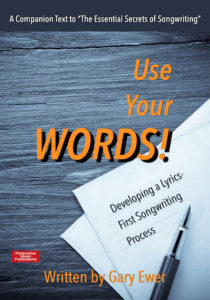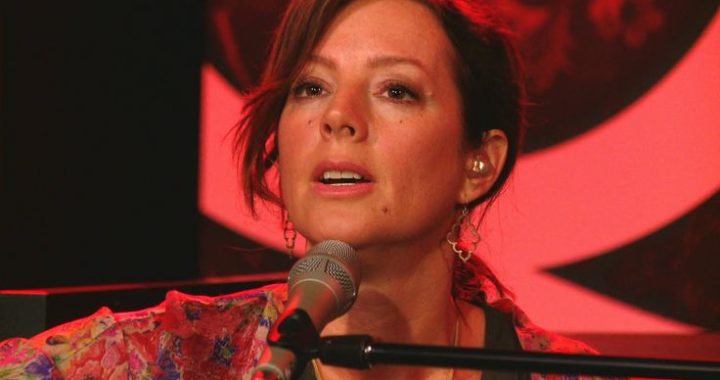“Adia” (Pierre Marchand, Sarah McLachlan) is one of Sarah McLachlan’s most successful singles, her first top 5 on the Billboard Hot 100 back in 1998. From a musical point of view it’s probably most notable for its beautiful melody and creative chord progression, and well worth a quick study.
MELODY
The melody (in C minor/Eb Major) has two distinctive sections, a first part that moves freely from the midrange, then down to the lower notes of McLachlan’s range (“Adia, I know I’ve let you down..”), then leaping upward to give us kind of climactic high point for the verse (“…love you in my way/ It’s easy, let it go..”):
 The melody has some interesting moments, including some attempts at what we call word painting, which is an attempt by the songwriters to convey the meaning of the text through specific melodic characteristics. For just example, the words “let you down” are partnered with some of the lowest notes of the song.
The melody has some interesting moments, including some attempts at what we call word painting, which is an attempt by the songwriters to convey the meaning of the text through specific melodic characteristics. For just example, the words “let you down” are partnered with some of the lowest notes of the song.
In a less obvious way, the leap upward on “It’s easy…” is the kind of melodic shape that emphasizes the meaning of the words — it helps us to feel them, in a way.
 Are you ready to have LYRICS play a much more important role in your songwriting process. You need to read “Use Your Words! Developing a Lyrics-First Songwriting Process.” Right now, it’s FREE with your purchase of “The Essential Secrets of Songwriting 10-eBook Bundle”
Are you ready to have LYRICS play a much more important role in your songwriting process. You need to read “Use Your Words! Developing a Lyrics-First Songwriting Process.” Right now, it’s FREE with your purchase of “The Essential Secrets of Songwriting 10-eBook Bundle”
The second verse starts as the first, but then changes to give us its second distinctive quality: a melody that becomes much more static, focusing mainly on the F-G midrange as the lines become shorter and punchier:
There’s no one left to finger
There’s no one here to blame
There’s no one left to talk to, honey
And there ain’t no one to buy our innocence
That static quality of the melody as the chords underneath move toward the chorus gives those lines a kind of pre-chorus feel, and we hear the musical energy building to the eventual start of the chorus.
CHORDS
Ballads typically use more creative progressions than uptempo songs. That’s usually because slower tempos allow listeners to process more complex chords, and that’s true in practically any genre of music.
There are some really nice moments in both the verse and chorus in “Adia”:
VERSE:
Cm Ab Eb Cm Ab Gm| Eb Ab Eb/G Cm….. F7 Eb Bb
The F7 is a secondary dominant chord – a major chord when we’d normally be expecting a minor (Fm normally belongs to Eb major).
CHORUS:
Eb Dbdim Ab Fm Bb| Gm Dbdim Fm G7
The second Dbdim in that progression almost comes across as a C7 with the bass playing an appoggiatura Db note. In any case, it’s another really lovely moment in the progression.
The chorus chords end on G7 which makes the transition back to the Cm chord at the start of the 2nd verse easier.
LYRICS
It’s a common songwriting technique to use quicker vocal rhythms in a song’s verse and then switch to longer note values in the chorus, and we get that in “Adia”. The verse lyrics come as a combination of 8th-notes and 16ths through much of the verse.
Then in the chorus the rhythms elongate, become based more on a combination of 8ths and quarter notes. That gives a more relaxed feel to the lyric, but the real reason songwriters make that change has to do with lyrical emotion: lyrics feel deeper, more poignant and emotional when note durations become longer.
In the lyric itself, we’re never given a clear indication who she’s singing about, but in any case it seems to be a loved one needing guidance and advice. You’ll note the difference between the kinds of words and phrases that we see in the verse: “…I do believe I’ve failed you/…I know I’ve let you down..”…I tried so hard..”, etc. We tend to pick up a general downward direction from the melodic fragments that get paired with many of those lines.
By contrast, the chorus feels more hopeful: “We are born innocent…” “believe me…”, “it’s easy”, and so on. And partnered with those more hopeful lines we pick up a general upward direction from the melody.
SUMMARY
There are many principles of good songwriting, but one of the most important ones is that all song elements partner together to produce a good song. In other words, melodies are only ever amazing if they partner well with the lyrics and chords.
Chord progressions can never be killer progressions if they aren’t supporting a great melody. How any one song does that is different, and getting all the parts working together is, in fact, what good songwriting always is.
In “Adia,” we get a kind of songwriting clinic on how important it is to consider the partnership of components as being crucial to the success of a song. In that sense, any good song is always better than the sum of its parts.
 Written by Gary Ewer. Follow Gary on Twitter.
Written by Gary Ewer. Follow Gary on Twitter.
 “The Essential Secrets of Songwriting” eBook bundle includes “Writing a Song From a Chord Progression.” Discover the secrets of making the chords-first songwriting process work for you. Comes with a Study Guide.
“The Essential Secrets of Songwriting” eBook bundle includes “Writing a Song From a Chord Progression.” Discover the secrets of making the chords-first songwriting process work for you. Comes with a Study Guide.










